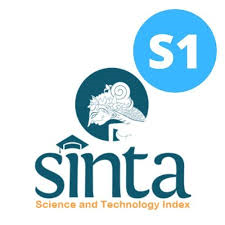DIVERSITY OF PLANTS USED FOR PLAITED CRAFTS BY THE DAYAK IBAN-DÉSA IN KABUPATEN SINTANG, KALIMANTAN BARAT, INDONESIA
Abstract
Keywords
Full Text:
PDFReferences
ALLOY, S. ALBERTUS. CHATARINA, P. I. 2008. Keberagaman subsuku dan bahasa Dayak di Kalimantan Barat. Institut Dayakologi, Pontianak.
BALL, M. D. 2013. The sieve and the winnowing tray: A typology of winnowing trays and related plaitwork. In: SELLATO, B. Plaited arts from the Borneo rainforest. Yayasan Lontar, Jakarta. Pp. 436–444.
BLÉHAUT, J. 2013. Iban baskets: their production and function. In: SELLATO, B. Plaited arts from the Borneo rainforest. Yayasan Lontar, Jakarta. Pp. 104–119.
CHRISTENSEN, H. 2002. Ethnobotany of the Iban and the Kelabit. University of Aarhus Denmark, Denmark.
CHRISTENSEN, H. 2013. Fiber and dye plants in two longhouse communities. In: SELLATO, B. Plaited arts from the Borneo rainforest. Yayasan Lontar, Jakarta. Pp. 40–53.
COUDERC, P. 2013. Cultural and literary aspects of Uut Danum patterned plaiting. In: SELLATO, B. Plaited arts from the Borneo rainforest. Yayasan Lontar, Jakarta. Pp. 294–312.
DRANSFIELD, J. 1979. A Manual of the Rattans of the Malay Peninsula. Forest Department Ministry of Primary Industries, Malaysia.
DRANSFIELD, S. & WIDJAJA, E. A. (Eds.). 1995. Plant Resources of South East Asia (PROSEA) No. 7: Bamboos. Backhuys Publisher, Leiden.
FACHRUL, M. F. 2007. Metode Sampling Bioekologi. Bumi Aksara, Jakarta.
HAJAR, I. 2009. Status pengetahuan keanekaragaman hayati tumbuhan pada masyarakat di Hutan Lindung Sungai Wain Kalimantan Timur. Bogor Agricultural University, Bogor. [Master Thesis].
HANDAYANI, D. & ARIYANTI, N. S. 2015. Perbedaan vegetatif dua jenis ekonomi Etlingera yang dipakai penduduk Bogor. Floribunda. 5(2): 48–52.
HENDRA, M. 2009. Etnoekologi perladangan dan kearifan botani lokal masyarakat Dayak Benuaq di Kabupaten Kutai Barat, Kalimantan Timur. Bogor Agricultural University, Bogor. [Doctoral Dissertation].
HEYNE, K. 1987. Tumbuhan Berguna Indonesia I. Badan Penelitian dan Pengembangan Kehutanan, Jakarta.
JASNI & ROLIADI, H. 2011. Daya tahan 16 jenis rotan terhadap bubuk rotan (Dinoderus minutus Fabr.). Jurnal Penelitian Hasil Hutan. 29(2):115–127.
JASNI & KRISDIANTO. 2012. Species and distribution of rattan in Indonesia. (http://arknfpd.org/index.php/product/detail/Species-and-Distri bution-of-rattan-in-Indonesia#.VsKuWEAyKKE). Accessed 21 February 2016.
JUMIATI, HARIYADI, B. & MURNI, P. 2012. Studi etnobotani rotan sebagai bahan kerajinan anyaman pada Suku Anak Dalam (SAD) di Dusun III Senami, Desa Jebak, Kabupaten Batanghari, Jambi. Biospecies. 5(1): 33–41.
LENJAU, M., SIRAIT, M. T. & SELLATO, B. 2013. Rattan and bamboo handicrafts of the Kenyah. In: SELLATO, B. Plaited arts from the Borneo rainforest. Yayasan Lontar, Jakarta. Pp. 205–223.
LÓPEZ, C. & SHANLEY, P. (Eds.). 2005. Kekayaan hutan Asia. PT Gramedia Pustaka Utama, Jakarta.
MACKINNON, K., HATTA, G., HALIM, H. & MANGALIK, A. 2000. Ekologi Kalimantan. Prehallindo, Jakarta.
MASHMAN, V. & NAYOI, P. 2013. Body and soul: Bidayuh baskets at Kampong Gayu. In: SELLATO, B. Plaited arts from the Borneo rainforest. Yayasan Lontar, Jakarta. Pp. 80–92.
NGO, M. 2013. The basketry of the Kelabit at Long Peluan and their neighbors. In: SELLATO, B. Plaited arts from the Borneo rainforest. Yayasan Lontar, Jakarta. Pp. 243–247.
PURWANTO, Y. & MUNAWAROH, E. 2010. Etnobotani jenis-jenis Pandanaceae sebagai bahan pangan di Indonesia. Berk. Penel. Hayati Edisi Khusus. 5A: 97–108.
RAO, I. V. R. & SASTRY, C. B. (Eds.). 1995. Bamboo, people and the environment. Proceedings of the 5th International Bamboo Workshop and The IV International Bamboo Congress 19–22 June 1996. Ubud, Indonesia: 1.
RUMPHIUS, G. E. 2011. The Ambonese Herbal Volume I: Introduction and Book I: Containing all sorts of trees, that bear edible fruits, and Husbanded by People. In: BEEKMAN, E. M. (translator & ed). Yale University Press, United States.
SADSOEITOEBOEN, M. J. 1999. Pandanaceae: A spek Botani dan Etnobotani dalam kehidupan suku Arfak di Irian Jaya. Bogor Agricultural University, Bogor. [Master Thesis].
SANUSI, D. 2012. Rotan kekayaan belantara Indonesia. Brilian Internasional, Surabaya.
SELLATO, B. 2013. Plaited arts from the Borneo rainforest. Yayasan Lontar, Jakarta.
SETYAWAN, A. D. 2001. Anatomi sistematik pada anggota familia Zingiberaceae. BioSMART. 3(2): 36–44.
SOFIAH, S. 2013. Ekologi dan bioprospeksi bambu di kawasan Wisata Alam Gunung Baung Pasuruan Jawa Timur. Bogor Agricultural University Bogor, Bogor. [Master Thesis].
SUKAWI. 2009. Pemberdayaan bambu sebagai bahan bangunan perumahan yang ekologis. Diskusi Nasional Arsitek Sastra Matra 9 Juni 2009. (http://eprints.undip.ac.id/32382/). Accessed 23 February 2016.
SUTARNO, H. NASUTION, R. E. & MOGEA, J. P (ed). 1994. Seri Pengembangan PROSEA 6.1. Rotan: Pembudidayaan dan Prospek Pengembangannya. Yayasan Prosea, Bogor.
TANTO, R. N. T. & SETYAWATI, R. 2009. Pemanfaatan ekstrak rempah-rempah sebagai bahan pengawet alami pada mie. Seminar Nasional Persatuan Ahli Teknologi Pangan Indonesia 3-4 November 2009. (https://www.researchgate.net/publication/260336922_Pemanfaatan_ekstrak_remp ah-rempah_sebagai_bahan_pengawet_Alami_pada_ Mie). Accessed 23 February 2016.
TURNER, N. J. 1988. The importance of a Rose: evaluating the cultural significance of plants in Thompson and Lilloet Interior Salish. American Anthropologist. 90(2): 272-290.
ULUK, A., SUDANA, M. & WOLLENBERG, E. 2001. Ketergantungan masyarakat Dayak terhadap hutan di Sekitar Taman Nasional Kayan Mentarang. Center for International Forestry Research (CIFOR), Jakarta.
WALUJO, E. B. 2004. Pengumpulan data etnobotani. In: RUGAYAH, WIDJAJA, E. A. & PRAPTIWI. Pedoman pengumpulan data keanekaragaman flora. Pusat Penelitian Biologi — Lembaga Ilmu Pengetahuan Indonesia, Bogor. Pp. 77–92.
WARDAH, MOGEA, P. J. & SUJADI, A. 2005. Rotan di TNGHS prospeknya di Kabupaten Lebak, Banten: Laporan Teknik Penelitian Ekologi dan Keanekaragaman Hayati di Kawasan Konservasi di Jawa Bagian Barat. Pusat Penelitian Biologi — Lembaga Ilmu Pengetahuan Indonesia, Bogor.
WARDAH & SETYOWATI, F. M. 2009. Ethnobotanical study of the genus Pandanus L.f. in certain areas in Java, Indonesia. Biodiversitas 10(3): 146–150.
WIDJAJA, E. A. 2012. Bambu Indonesia, budidaya dan cara panennya. (https://bamboeindonesia.wordpress.com). Accessed 25 August 2014.
Refbacks
- There are currently no refbacks.









